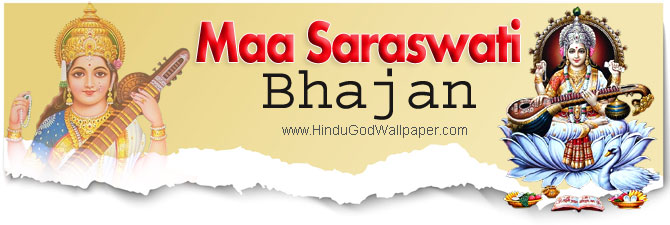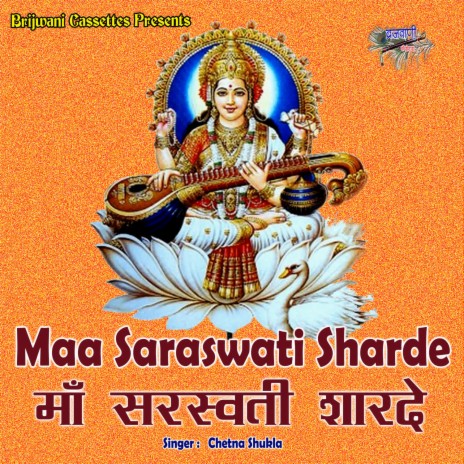
In Konkani, she is referred to as Shārada, Veenapani, Pustakadhārini, Vidyadāyini. In the Telugu, Saraswati is also known as Chaduvula Thalli (చదువుల తల్లి) and Shārada (శారద). In the Hindi language, her name is written Hindi: सरस्वती. The oldest known Saraswati-like relief carvings are from Buddhist archaeological sites dated to 200 BCE, where she holds a harp-style veena. The Hindu Goddess Saraswati has been pictured holding different veenas over the centuries. Thus, the name Saraswati would translate to "She who helps realize the essence of self" or "She who reconciles the essence (of Parabrahman) with one's self".

In some interpretations, "Sara" is translated as "Essence", and "Sva" is translated to "Self". The Goddess Saraswati is also known as Vidyadatri (Goddess who provides knowledge), Veenavadini (Goddess who plays Veena, the musical instrument held by Goddess Saraswati), Pustakdharini (Goddess who carries a book), Veenapani (Goddess who carries a veena in her hands), Hansavahini (Goddess who sits on swan) and Vagdevi (Goddess of speech). Some examples of synonyms for Saraswati include Brahmani (power of Brahma), Brahmi (goddess of sciences), Bharadi (goddess of history), Vani and Vachi (both referring to the flow of music/song, melodious speech, eloquent speaking respectively), Varnesvari (goddess of letters), Kavijihvagravasini (one who dwells on the tongue of poets). Saraswati is known by many names in ancient Hindu literature. In Upanishads and Dharma Sastras, Saraswati is invoked to remind the reader to meditate on virtue, virtuous emoluments, the meaning and the very essence of one's activity, one's action.

Her importance grows in Vedas composed after Rigveda and in Brahmanas, and the word evolves in its meaning from "waters that purify", to "that which purifies", to " vach (speech) that purifies", to "knowledge that purifies", and ultimately into a spiritual concept of a goddess that embodies knowledge, arts, music, melody, muse, language, rhetoric, eloquence, creative work and anything whose flow purifies the essence and self of a person. In hymns of Book 10 of Rigveda, she is already declared to be the "possessor of knowledge". In Vedic literature, Saraswati acquires the same significance for early Indians (states John Muir) as that accredited to the river Ganges by their modern descendants. May they who purify with butter, purify us with butter,įor these goddesses bear away defilement,

Saraswati is celebrated as a feminine deity with healing and purifying powers of abundant, flowing waters in Book 10 of the Rigveda, as follows: īest of mothers, the best of rivers, best of goddesses, Sarasvatī. In Book 2, the Rigveda describes Saraswati as the best of mothers, of rivers, of goddesses. In initial passages, the word refers to the Sarasvati River and is mentioned as one among several northwestern Indian rivers such as the Drishadvati. The word Saraswati appears both as a reference to a river and as a significant deity in the Rigveda. It is also a Sanskrit composite word of surasa-vati (सरसु+अति) which means "one with plenty of water". Originally associated with the river or rivers known as Saraswati, this combination, therefore, means "she who has ponds, lakes, and pooling water" or occasionally "she who possesses speech". Saraswati, is a Sanskrit fusion word of saras (सरस्) meaning "pooling water", but also sometimes translated as "speech" and vati (वती) meaning "she who possesses".

#Maa saraswati sharde dance how to
Some Hindus celebrate the festival of Vasant Panchami (the fifth day of spring, and also known as Saraswati Puja and Saraswati Jayanti in so many parts of India) in her honour, and mark the day by helping young children learn how to write the letters of the alphabet on that day. Each of these items have symbolic meaning in Hinduism. She is generally shown to have four arms, holding a book, a rosary, a water pot and a musical instrument called Veena. She has remained significant as a goddess from the Vedic period through modern times of Hindu traditions. The earliest known mention of Saraswati as a goddess is in the Rigveda. She is a part of the tridevi of Saraswati, along with Lakshmi and Parvati. Saraswati ( Sanskrit: सरस्वती, IAST: Sarasvatī) is the Hindu goddess of knowledge, music, art, speech, wisdom, and learning.


 0 kommentar(er)
0 kommentar(er)
